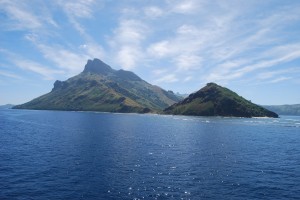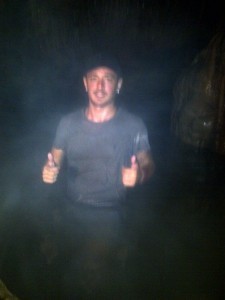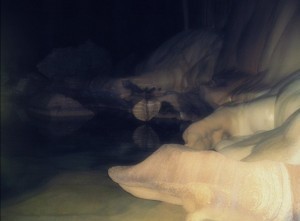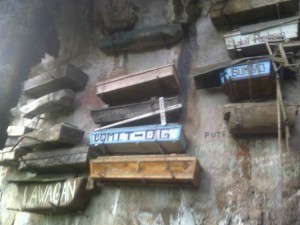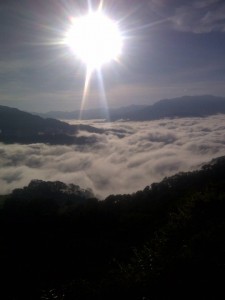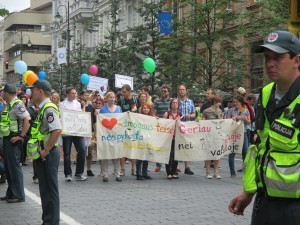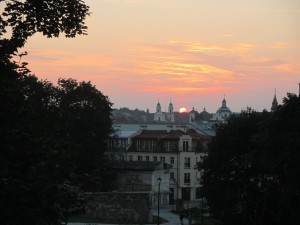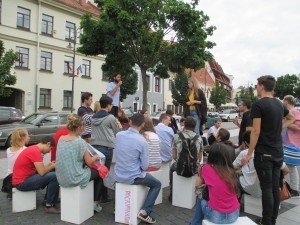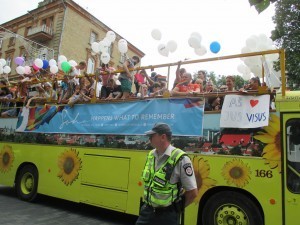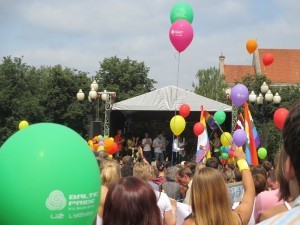Lisa Niver's Blog: We Said Go Travel, page 467
September 17, 2013
Myanmar: On the Road to Mandalay from Meiktila (video)
Watch: 40 Day 2 on the Road to Mandalay from Meiktila, Myanmar (Burma)
We Said Go Travel http://www.wesaidgotravel.com/ October 24, 12 Honey Hotel has issues, trash around the lake, unidentifiable food but friendly staff! My suggestions for this hotel: clean up the hallway, stairwells, and rooms especially the refrigerator. I did not included the video of the moldy dirty refrigerator but really if you are going to have one. You have to clean it. Adding a choice at breakfast like different types of eggs, fruit and clearing a path to the Lake would all be good improvements.
We tried to wander around the lake. I think a promenade around the lake would do wonders. Lonely Planet says you can bike around the lake but then again they said ask for room G2 in a building that seems long gone. Not sure the Lonely Planet reporters have been here in decades.
We did not see the British officers quarters where Aung San Suu Kyi and husband honeymooned. We did see many pagodas, monks asking for alms and school children in green longyi uniforms.
We walked to the main road from the guesthouse in about six minutes, we stopped after we crossed the street and instantly there was a bus. We said, “Mandalay.” They said, “yes,” so we hopped on. At first it seemed far too crowded but I jumped over a motorbike and there were two seats in the last row.
Within about ten minutes many of the passengers got off and we wondered if we were going to the Meiktila bus station but we zoomed on. We got on the bus around 9:30am and arrived at the Mandalay station 12:30pm. We had one stop for food around 11am but we were not hungry so we just waiting and stretched our legs.
There were many stupas, fields and tollbooths along the way. Road construction is a big priority and I was told that private companies are doing the building and they can charge tolls. If they try to overcharge, they will lose their right to the route.
Back at ET Guesthouse, the man at the desk seemed surprised when I said, “Do you need the passports? We were here three weeks ago.” I think now that the Air Asia route is open from Mandalay to Bangkok; they will start to see more repeat guests. Unless people do the route like us like and fly into Yangon and out of Mandalay.
George told me today we have spent about $1300usd in 27 days(not including our flights). We changed $680 to kyat. My dumb money move was trying to open PayPal in Myanmar. It is a sanctioned country for PayPal. I cannot believe I am in Paypal Jail AGAIN on this trip!
This movie is from our 28 days in Myanmar (Burma) from September 28, 2012 to October 26, 2012 and our year TRIP in South East Asia, see all the videos from our trip.
Our Memoir, Traveling in Sin, is available on Amazon.
Traveling in Sin is a HOT NEW Release on Amazon! from Lisa Niver Rajna
Traveling in Sin is a true tale of TRANSFORMATION thought LOVE and TRAVEL! After meeting online (on two different sites), George and Lisa travel internationally, give up their jobs, condo, ice cream and toilet paper in search of adventure and love. Along the way, Lisa sheds over 60 pounds and the couple gets engaged underwater in Thailand. There are tears, twists and true love!
Recent Press:
By Amy Sommer on Westside Today
By Dani Stone on Diets in Review
The post Myanmar: On the Road to Mandalay from Meiktila (video) appeared first on We Said Go Travel.
September 15, 2013
Fiji: From Mold to Sun
Foul smelling, damp and also a little crusty, Chris and I were starting to feel like the inside of a teenage boys soccer bag that had not been cleaned for weeks on end. Night after night we laid on our backs looking at the expanding patches of green, fuzzy mold on the ceiling of our car while contemplating our plan. We were ten months into our goal to live in New Zealand for a full year. We weren’t ready to go home yet, but attempts at finding just the right niche for us were not falling into place as we had a running bet as to how big the patch of mold would grow before we made our next big decision.
Unfolding the heavily worn and tattered seems to our world map we looked to see what was close to New Zealand and a cheap flight and our eyes landed on Fiji. At the time we were unfamiliar with island countries of the South Pacific and went into the Student Travel Association (STA) to ask a booking agent some questions. A woman with chestnut brown hair and bright red lip stick called us to her desk. We had three questions for her:
1.) Was there a war?
2.) Did we need vaccinations?
3.) Was it peak hurricane, monsoon or other natural disaster season?
She answered, “No, no and no.” On the spot we bought plane tickets leaving three days later for Fiji.
We bounced all around Auckland seeing the last attractions we wanted before departure and then boarded a plane to dry season Fiji. Within the first step off the plane our lungs tried to adjust to the high heat and humidity as we entered the open non-airconditioned airport in Nandi. Softly strung guitar strings filled the air as a handful of Fijians dressed in brightly colored flower shirts welcomed us new arrivals to their country.
Prior to leaving New Zealand we had secured a spot with a home stay for our first two nights. Our general rule of travel is to always book at least the first, if not two nights of accommodation when arriving to a new country. Via email, our home stay host Dee instructed us to ensure our taxi driver did not charge us more than $5 to bring us to her house. I wasn’t prepared for the on-slot of drivers vying for our business, yet somehow we picked one driver from the crowd and agreed on the price. We loaded our gear and he took us away in the dark. There were no street lights in this still developing country as we traveled down narrow, pot holed dirt roads with vegetation scraping the windows alongside the car. When we scanned for a driver we followed all the safety precautions and looked for certificates with the proper issued license plate to know we had a legit driver, yet I remembered feeling so vulnerable during that drive.
About ten minutes later, our driver stopped in front of a dark gated house. A large Fijian man emerged from the shadows and unlocked various locks on the gate. He quickly grabbed our bags and we followed him toward the dim light of the house while our driver sped away. Once inside, a heavy set woman with dark frizzy hair, large, white spaced teeth and dressed in a bright pink and white matching floral skirt and shirt, our host Dee greeted us as if we were long 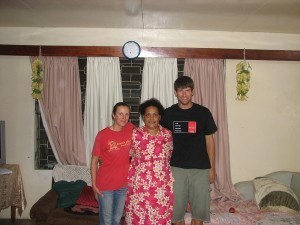 lost family. The man holding our bags was Gerald her oldest son, who went every morning to get us fresh bread for breakfast. Even though the hour was late Dee insisted she make us dinner and she declared it would be soup. As thankful as I was for the food, consuming hot soup on our first night in the heat and humidity of Fiji felt like I was eating a bowl of chilies. Despite Dee seating us closest to her one white fan that slowly rotated on crooked legs back and forth in her living room, it was just not enough to keep the beads of sweat from continually running down our entire bodies. We were used to temperatures of at least 40 degrees less and to be eating soup was almost akin to finger nails repetitively scraping on a chalk board. None the less, we stayed up late into the evening sharing stories with Dee back and forth about each other’s lives.
lost family. The man holding our bags was Gerald her oldest son, who went every morning to get us fresh bread for breakfast. Even though the hour was late Dee insisted she make us dinner and she declared it would be soup. As thankful as I was for the food, consuming hot soup on our first night in the heat and humidity of Fiji felt like I was eating a bowl of chilies. Despite Dee seating us closest to her one white fan that slowly rotated on crooked legs back and forth in her living room, it was just not enough to keep the beads of sweat from continually running down our entire bodies. We were used to temperatures of at least 40 degrees less and to be eating soup was almost akin to finger nails repetitively scraping on a chalk board. None the less, we stayed up late into the evening sharing stories with Dee back and forth about each other’s lives.
We came and went from Dee’s Place the rest of our time in Fiji. Using it as a home base, we stored all our extra gear there, borrowed her sheets and she cooked us amazingly delicious meals from seemingly out of nowhere in her bare kitchen. Dee openly offered us whatever she had and we couldn’t have imagined not meeting her during our time in Fiji. Even as we were leaving for the airport, she came running after us yelling, “Wait, here you two enjoy one last piece of fruit (which she just picked fresh from her tree).”
For two weeks we island hopped up and down the Yasawa Islands and another two weeks traveled around the main land. We snorkeled with hundreds of species of fish, swam in caves, and had dance parties with the locals while eating lovo lovo, a traditional way of cooking food underground with hot coals.
Our time in Fiji was filled with fond memories, lasting friendships and new experiences. When we said our goodbyes to Dee, we left her with a special gift to express our gratitude for the generosity she had shown to us. The whole process leading up to decision to go to Fiji was a valuable lesson for us as long term travelers. Sometimes it’s ok to change your original plan, leave a country earlier and change course. If the weather turns cold and your car is moldy, it just might be a good time to jump countries.
The post Fiji: From Mold to Sun appeared first on We Said Go Travel.
Myanmar: Local bus from Inle Lake to Meiktila (video)
We Said Go Travel http://www.wesaidgotravel.com/ October 23, 2012 We wanted to travel during the day from Inle Lake to Mandalay. They kept saying, “no” to us. There is only the evening bus from Inle Lake to Mandalay 10,000K per person with air conditioning. But we knew there had to be a way to go during the day and without air con.
We left Golden Empress Hotel by Tuk Tuk around 10am for a surprising 35min ride to the junction for 6000K. We did not think it would be so far but it was. Immediately as we crossed the street a man said to us, “Meiktila?” We said yes, and were offered 5000K each for the middle row of the back of the truck or 8000K per person for the front seat. They shoved our bags under the seats on the dusty floor, we climbed in and we were nearly off by quarter to eleven.
It was definitely the milk run and we stopped many times to add more people, let people off, get betel nut, water, oranges all sorts of things. At one point an additional seven young men threw their large carry sacks in the back and all climbed ontop of the bus with the large satchels of green beans.
We went through Kalaw and stopped for lunch somewhere but we only got butter bread roles and soy beans. I went to a grimy outhouse but at least it was there. I loved the fields of rice and corn and all the oxen. Coming down the steep hills we had to stop half way and water the tires. I found a truck with a tire that seemed to be on its last day. We got to Thaza and knew we were close. We saw a beautiful sunset over a lake and thought we made it but we kept going.
At the bus station in Miektila, they offered us 1000K per person for motorbike or 3000K for 2 in a tuk tuk as it was 1km we decided to walk. We saw the clock tower and the mosque. We found Lekker Corner which we came back to for dinner (Thai and Chinese food). A nice man on a motorbike helped us find the right street and we saw both $25 and $35 rooms. The pricier ones have TV and refrigerator; there is only wifi in the lobby. We looked at two rooms and were not so impressed as the $35 had such a dirty floor. I asked for room G2 as the Lonely Planet suggested but that building does not exist anymore. George looked at two more rooms and found #202. After we dusted off our bags, we opened the refrigerator and saw how disgusting dirty it was. There is another hotel in this city but not in town. This would be our most expensive night in our 27 days in Myanmar.
Aung San Suu Kyi had her honeymoon here in this town but I think not in this hotel.
Bus to Mandalay: one company one bus leaves at 11:30pm, and arrives 4am
Another company: 5am bus to Mandalay
Front desk at the hotel suggested to take a mini bus at 8am, 9am, 10am, or noon.
Breakfast was available from 7-10am inside or outside as you wish.
Honey Hotel, Maung Maung, Panchan Street, Meiktila, 064-23588
This movie is from our 28 days in Myanmar (Burma) from September 28, 2012 to October 26, 2012 and our year TRIP in South East Asia, see all the videos from our trip.
Our Memoir, Traveling in Sin, is available on Amazon.
Traveling in Sin is a HOT NEW Release on Amazon! from Lisa Niver Rajna
Traveling in Sin is a true tale of TRANSFORMATION thought LOVE and TRAVEL! After meeting online (on two different sites), George and Lisa travel internationally, give up their jobs, condo, ice cream and toilet paper in search of adventure and love. Along the way, Lisa sheds over 60 pounds and the couple gets engaged underwater in Thailand. There are tears, twists and true love!
Recent Press:
By Amy Sommer on Westside Today
By Dani Stone on Diets in Review
The post Myanmar: Local bus from Inle Lake to Meiktila (video) appeared first on We Said Go Travel.
September 14, 2013
Return to Bhutan
RETURN TO BHUTAN
Yet again I find myself at the Drukair check in counter of Bangkok’s Suvarnhabumhi airport, at the unreasonable hour of 4:30 a.m. Twelve Bhutan bound clients make up my entourage. The usual grumpy Thai staff processes our bags and tickets and scrutinizes visas, not the best introduction for the happiest place on earth. Last opportunity for good coffee I caution, as finding good coffee in Bhutan about at difficult as finding a good steak in India.
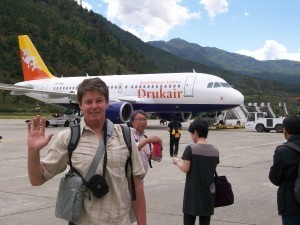
Arrival in Paro, BHUTAN
Caffeine craving temporarily satisfied, we board the daily flight from Bangkok to Bhutan. Drukair is the only airline to service Bhutan, and does so with a handful of flights from Thailand, India and Nepal. As befits an airline serving a country known as the last Shangri La, and the land of Gross National Happiness the staff try hard to please, with abundant smiles and food and even booze for those with want it with breakfast. I hear a curious sound as we taxi, a sort of pumping sound and ask a flight attendant the source of it. I am not alarmed, though am surprised when not long after take off the purser asks me to come with her to explain the problem to the pilot. I’m hustled up through business class cabin into the cockpit. “No problem” I hasten to say as pilot and I introduce ourselves, just curious about the sound. It’s a hydraulic pump at work; sometimes the duration is longer so passengers notice it, but very standard procedure. The friendly pilot and mechanic (they carry a mechanic in case they need to make unscheduled landing in area where there may not be mechanic) provide me with so much detail about this I’m unable to absorb it all, but I’m more than satisfied we are flying with a tiptop airline. Drukair pilots need special training to land in Paro, Bhutan the world’s most challenging runway and the planes engines have additional power to get them off the ground at the airport’s 7400’ elevation.
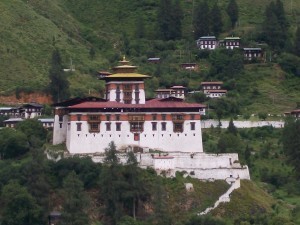
17th century Paro Dzong, fortress/monastery
We fly 3 uneventful hours, and then land for refueling in Bagdogra, India. Only 35 air minutes separate Bagdogra from Paro, and this is the leg of the flight where you really get good value for your money in terms of ticket price. Shortly after take of the pilot points out Everest, Kangchenjunga and K2 of the left side of the plane, the spine of the Himalayas like a jagged saw, as pointy white peaks jut above a bank of soft cumulus clouds. Despite the lit seatbelt sign, all the passengers stand and move to the left side of the plane, so that I almost expect the plane to list, which of course it does not do. Not too many minutes later, the plane in descends into cottony clouds and the view is lost, while simultaneously soft and melodic chanting music emerges from the PA system. When the plane emerges below the cloud cover, it is soon apparent we are flying down a long narrow and curving valley. Green forested mountains studded with 3 story stone and timber houses and vertical clusters of 108 white prayer flags appear right below or more alarmingly to the right or left of the plane. There is not any flat land to be seen, as the folds and creases of the mountainsides undulate far as the eye can see. The entire cabin is transfixed, people murmuring “oh my” and “how lovely” as the plane continues to seemingly float down the valley at what appears to be a slow speed, so fine is the view. Bhutan is about as verdant as it ever gets now, after the summer rains, and this lush terrain is all around the plane, or so it appears. The homes are now level with the plane, and many even above the plane, a most unusual feeling for those of us inside this metal tube, where the expectation is to look down to view these sights, not crane ones neck upward to see them.
When finally is seems we can get no closer to the ground without touching it, Bhutan’s sole runway appears and the wheels of the plane make smooth contact with it and all 170 passengers begin to applaud. The applause of those who just appreciated a virtuoso performance, rather than the applause of thanks they are still alive I have at times witnessed and participated in elsewhere in the world. Of all my many landings in Bhutan, this was by far the most sublime, and without a doubt most memorable. For the rest of the day my clients talk about this, what a grand introduction.
As always, I am thrilled to have returned to the real Magic Kingdom.
ABOUT THE AUTHOR
John Leupold owns and operates Champaca Journeys, offering small groups cultural tours to Bhutan, Laos, Cambodia and Mexico. Mr. Leupold worked as a landscape designer until the travel bug took over his professional life, now his commute to work takes much longer, though he has absolutely no regrets about life as a tour operator.
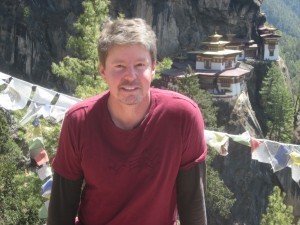
John at Tiger’s Nest Monastery
The post Return to Bhutan appeared first on We Said Go Travel.
September 13, 2013
Philippines: Caves, Coffins and Clouds
I was at the end of my trip of Asia. 10 hours from Manila, 3 hours through Banaue and Bontoc. 13 hours in total. I had little time left in the Philippines so I had one day to do Sagada. I actually remember first hearing about the place when I was in Laos. A couple of travellers from Toronto told me about them, one girl in particular. I remember thinking at the time, that’s worlds away for me, almost unrealistic. That was at the start of my trip. Well here I was it was 8 months on. I arrived at Georges Guesthouse at 11.30am in Sagada. I almost instantly went to go find a tour guide to take me caving. I remember paying around 800 peso to the guide. By this time it was the afternoon, and we had a lot to do before getting heading back.
My guide had been trekking for years. His appearance deceived him. A local of course, short, chubby, maybe in his 40-50’s. We walked down to Samaguing Cave. I realised my Vans were not going to help me despite the tour guide saying they’d be okay. I went barefoot. We climbed down the caves and I have to say, very carefully for me. He had great flexibility and strength for his physique. We got to the bottom of the caves after my cautious effort and the help of my guides rubber limbs. The final venture was the most challenging part, caving under, into the water and back around to begin our exit. This was NOT for the ones with claustrophobia. I was honestly quite freaked out but something kept me going. I trusted him and just kept moving. It reminded me a bit of the Qui Chi tunnels in Vietnam. Try not to think. Keep moving. We had to climb down with ropes, swim through tight cave formations, all with balance and precision. The water was shallow but the rocks were sharp and awkward everywhere. The space was limited. My heart was pumping. It was exciting but I was too worried that an unknown bout of uncontrollable worry might creep in at any second. I was too determined to stop and reflect.
On the climb back up, worries became reality I slipped, falling a couple metres below. Luckily I fell into water. I remember the tour guides word of worry. Hearing this, whilst in the middle of my dramatic fall, for a split second I didn’t feel no comfort of survival. I was okay. I climbed up slowly after that, it was challenging but I was so happy to reach the top. It was a nerve racking experience, but when I look back I realised I enjoyed it. After all, that’s one of the reasons what I came for.
After that cave we trekked to the where the known hanging coffins were. The coffins had a mysterious feeling to them. They almost had a spell on them which made your mind flashback to their history and why they were there. It was very odd but something I definitely was glad about seeing. A unique site. Who’d of thought it? Trek all this week, travel up north to see a few coffins. That in itself was unique. I still get an intriguing feeling now when I think of these coffins. One of my more interesting exploits.
The next day after my body was battered from the travelling, lack of sleep, caving, trekking and early start, I managed to catch the 5.20am Jeepney back down to Banaue. It was such a delight to get up that morning. I’m not a morning guy, but when I do get up and I’m half awake, I love that peace that being up early in the morning brings. The moment where everything is slightly wet due to the morning residue, the birds are not yet fully in full song, the air is cold but refreshing, and the mind is at ease. I rode on top of the Jeepney again. When riding downhill and out of Sagada, what was before me was mesmerizing. We were that high up, oceans of clouds were smothering the land below us, wrapping around the hills and terraces. The sun had come out proud and was shining bright. My whole previous 18 hours had been fulfilled, bit this was the ending of my trip of Sagada. The view of the clouds topped it off. A sign of accomplishment to me. I achieved what I set out to do. Maybe it was that light at the end of the tunnel. In this case it was the clouds at the end of the caves.
The post Philippines: Caves, Coffins and Clouds appeared first on We Said Go Travel.
September 12, 2013
Valencia – City of Ghosts
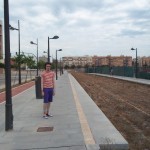 Valencia is not particularly well known. No image of it came to my mind, but a quick Google search informed me it was Spain’s third city, birthplace of paella, and cheap, so it seemed ideal for a getaway. It would turn out to be far more interesting.
Valencia is not particularly well known. No image of it came to my mind, but a quick Google search informed me it was Spain’s third city, birthplace of paella, and cheap, so it seemed ideal for a getaway. It would turn out to be far more interesting.
After arrival we head to the chief attraction. The architecture of the ‘Ciudad de las Artes y Ciencias’ complex is awe inspiring. From a distance, the alien shapes and curves, impossibly suspended concrete, sun dazzling from the white porcelain tiles coating, are redolent of an undiscovered civilisation. You can imagine some of the sense of awe the Conquistadors who left this city, might have had when first viewing Cusco or Tenochtitlan. There is nothing like it elsewhere.
And then as you approach, something isn’t quite right. You notice the fountains are not working. Algae creep over the ornamental lakes. The whiff of uncollected garbage permeates. And there are no people. Silence. This is El Dorado in sight of a motorway and container port, built right before the European financial collapse. An impression of sudden abandonment lingers, akin to a Mayan tomb. Highways without cars, weed-blown metro stations which have never seen a tram, garrisons of apartments which have no residents, empty offices and hotels, built on economic foundations that were never really there, for tourists who never much arrived.
Abruptly beyond are remains of what must have been before the credit explosion. Lost, we wander a western movie set of sliding pan-tiles, seedy bars, woebegone churches, dancing prostitutes, and big grinned children playing in the dust. You begin to appreciate why they might have blown the massive EU transfers afforded in the past. These streets give way in turn to old orange trees and olive groves heaving with ignored fruit, rice fields patrolled by knowingly beautiful egrets, pines, cactuses, and verdant scrub.
Next on the wide, as far as the eye can see, soft white sand bordering the bath warm Mediterranean, we are amongst people again. The beach is alive with play, touts, kids with Frisbees, couples flirting, picnicking families, narcissists posing. We catch the bus back with tired teenagers and salt flecked surfers. The central Turia Park, following the curves of an old riverbed, is filled with all ages jogging, skating, cycling, and doing yoga. In the old town’s squares and narrow streets, shops, bars and bistros spill onto the pavement. Crowds head towards the bullring. The flood of colour and atmosphere comes as a relief after the silence of before. But then the sun setting over the pinnacles of the Ciudad calls you back to its eerie grandeur and we wander alone amidst trailing bougainvillea as red as the heavy sky.
The city has a unique, almost dreamlike quality. Valencia is a fascinating place, where contrasts abut each other sharp and sudden. It is a place where recession is being played out in stark terms, where hope, failure, folly and creativity, overlap each other. This makes it an especially relevant place to visit in our time.
About the Author: Brendan Canavan: I am a UK PhD student studying tourism development and sustainability in small islands. I enjoy opportunities to travel and witness impacts of the industry first hand. I believe that tourism brings people together and creates economic opportunities that help to make the world a more cohesive place.
The post Valencia – City of Ghosts appeared first on We Said Go Travel.
Celebrations: Lisa in Jewish Exponent Article
Happy Birthday to my nephew, Zachary! In honor of his 16th birthday, I wanted to share about Jewish Celebrations and inclusion. Thank you to Elyse Glickman for including my thoughts in her article, Room for One More. As we move from Rosh Hashannah, through the ten days to awe to Yom Kippur, I always think about my goals for the New Year. This year I hope you and your family find ways to CELEBRATE EARLY and OFTEN!
(Click on the image to open in a new window)
From the Article:
Rabbi Abrahamson notes that teachers and education professionals have become more proactive with inclusiveness in their classrooms and in their lesson plans. One example of this is Lisa Niver Rajna, a Philadelphia native and Penn graduate who teaches K-6 science at Brawerman, a Jewish elementary school in Los Angeles. Throughout her career, she has ensured that her lesson plans include teachable moments about diversity, inclusion and bullying.
“We are social creatures – it is part of our genetics,” Niver Rajna says. “I start this concept with my second graders – we observe how caterpillars become butterflies. Some of the butterflies emerge but may have a wing with a problem. I leave all of riiem in the habitat. When we go outside to release them, we talk about how not everyone is the same. Some butterflies or people have a problem with a wing or a limb or a part of their body, but we are all part of the community.”
The post Celebrations: Lisa in Jewish Exponent Article appeared first on We Said Go Travel.
September 11, 2013
Baltic Pride, Vilnius: Different People, Same Love
I was sitting in Cathedral Square when the drum circle arrived. Or what looked like a drum circle. If drum circles also had clocks, like the kind of clock you would hang in your kitchen. Large roman numerals, round. Gold frames. They were walking straight toward me, carrying white blocks the size of trumpet cases, maybe forty of them, college students or slightly older, speaking English, heavily accented English, accents that didn’t match. I froze. The hard cement flowerbed behind me dug into my lower back. Cigarette smoke drifted in from multiple angles. My laptop teetered on my knees.
A goateed man in flannel and leather sidled up next to me. He looked down the length of his nose at my belongings scattered across the bench.
“Ah, you want to stay where you’re at, no?”
Did that mean stay or go? Sunshine broke through the clouds as if attempting to guide my decision. Two weeks in Vilnius had taught me to accept off-the-wall situations as an inevitable part of daily life. On any given day, I could wind up having lunch with strangers, staying out until three a.m. at any number of the lively bars or clubs, or joining a drum circle.
“You are from Lithuania, no?” Lithuania came out in two syllables.
“Yes. Wait, no. I have been here two weeks, so maybe it feels that way.” I laughed, a self-deprecating little laugh that masked the sense of disorientation I had felt since I had flown the four thousand miles to get there. Everything about July in Old Town Vilnius was beautiful – the architecture, the restaurants lining every street, the art, the people. But the white nights, the ubiquitous twilight, cast a sense of displacement I couldn’t quite navigate.
Maybe that was the point.
“I am from the U.S. I live in Nagoya, Japan. What is this here today?”
“We are the European Union Project for Youth Connection,” the goateed man said, flicking cigarette ash on the toe of my shoe. “You know LGBT? We are here to speak out against homophobia. Our theme is Different People Same Love. We perform in museum, and then we play in street here. Music. You know.”
“You are all from Vilnius, no?” I said. I moved my bag for him to sit down.
“Ah, we are from Greece, Italy, Poland, Spain, Turkey. Only some, Lithuania.”
A fair-skinned twenty-something woman in a cloth cape barked orders to the group from atop one of the blocks I now realized were seats.
“Get in your language groups!”
A flurry of stool scraping and sneaker shuffling ensued as the group dispersed into six groups. Each group spoke a different native language. After seven months living in Nagoya, where next to no one spoke English, I felt right at home.
* * *
The next day, I participated in the Baltic Gay Pride Parade. I had kicked off the weekend at Soho Club, Vilnius’ only gay bar, the night prior, dancing the night away to a vibe of thumping techno music. The club had been packed with homosexuals and heterosexuals alike, many wearing pins or carrying tiny flags in support of the weekend’s march.
The parade was historic. The parade marched down Gediminas Avenue, the central street of the main city within a historically homophobic country. Hundreds of police officers lined the streets. Men in full bomb squad fatigues and masks patrolled the edges of the event, primed for action should protestors grow hostile. There had been rumors of organized retaliation, of protestors charging the commons where the parade was to commence. Earlier in the day, I had dragged my suitcase over the cobblestone sidewalks along Gediminas Avenue. Every one of the dozens of cops I passed eyed me suspiciously, their heads following me as I walked by. I was searched multiple times. I am unarmed! I wanted to shout. I am here to support the parade!
The event was not without its challenges. Small groups of protestors waited in the wings, holding anti-gay signs, protesting through megaphones and throwing eggs. Some protestors were escorted off the premises.
But that the parade was happening gave people hope. That the parade was happening signified change.
“First they ignore you, then they ridicule you. Then they fight you, and then you win.”
The speeches on the main stage opened with this quote by Mahatma Gandhi. As I looked around at the thousands of brightly colored flags, the people from across the EU, the globe, marching for equal rights, the organization of which, overall, turned out to be a relatively peaceful demonstration, one word floated through my head. Progress.
The post Baltic Pride, Vilnius: Different People, Same Love appeared first on We Said Go Travel.
Gratitude Travel Writing Contest: Where do you feel AWE?
FALL 2013 GRATITUDE TRAVEL WRITING CONTEST
Free Entry $1,000usd in CASH PRIZESContest will run September 11 through November 28, 2013.
We are looking for an article about a place you are grateful for or a memorable holiday that you shared with a special loved one or a place that is awe inspiring.
In Jonah Berger’s book, Contagious: Why Things Catch On he wrote about awe:
he wrote about awe:
Awe is the sense of wonder and amazement that occurs when someone is inspired by great knowledge, beauty, sublimity, or might. It’s the experience of confronting something greater than yourself. Awe encompasses admiration and inspiration and can be evoked by everything from great works of art or music to religious transformations, from breathtaking natural landscapes to human feats of daring and discovery.
Sometimes the place that makes you feel gratitude is in your own backyard, share your special location.
THEME: Gratitude: A Place that inspires Awe
PRIZES:
1st Prize - $500usd cash and Travel Writing Road Map ($497usd value)
2nd Prize - $350usd cash and Travel Writing Road Map Self Study
3rd Prize - $150usd cash and Travel Writing Road Map Self Study
Winners will be selected by our judges, Richard Bangs, Tiffany Hawk and the We Said Go Travel Team. Cash prizes will be paid through PayPal in United States Dollars. All winning entries will be promoted on We Said Go Travel.
RULES: Publication is dependent on proper use of English language and grammar, appropriateness of theme topic, and being family friendly (G rated). If your post is written in a language other than English, please also send an English translation. Travelers of all ages and from all countries are encouraged to participate. Each individual may send up to 5 entries that are 500-800 words with 1 photo. Your article must be an original and previously unpublished piece. All posts, which meet the requirements, will appear on WeSaidGoTravel.com.
TO ENTER: Click here!
DEADLINE: Enter by midnight PST on November 28, 2013
JUDGING: Richard Bangs, Tiffany Hawk and the We Said Go Travel Team
Richard Bangs, the father of modern adventure travel, is a pioneer in travel that makes a difference, travel with a purpose. He has spent 30 years as an explorer and communicator, and along the way led first descents of 35 rivers around the globe, he is currently producing and hosting the new PBS series, Richard Bangs: Adventure Without End
Tiffany Hawk, is a former flight attendant and the author of Love Me Anyway, a darkly funny novel about life at 35,000 feet. She has an MFA in creative writing from UC Riverside and her work can be seen in such places as The New York Times, The Los Angeles Times, National Geographic Traveler, and NPR’s “All Things Considered.” Join Tiffany Hawk for the complete roadmap to exotic travel writing: Travel Writing Road Map.
Other Contests, Courses and Books about Travel Writing
The post Gratitude Travel Writing Contest: Where do you feel AWE? appeared first on We Said Go Travel.
September 10, 2013
Slovakia: Devin Castle on Bratislava’s Doorstep
Devin Castle was built on one of the finest pieces of real estate in Europe – atop a cliff 212 metres above the Danube, at the confluence of the Danube and the Moravia rivers. My friend and I took a boat from Bratislava to the ruins of Devin Castle in May, on one of the windiest mornings of our trip, with only light cardigans and cotton scarves for protection, and it was still an amazing, if slightly chilly, experience.
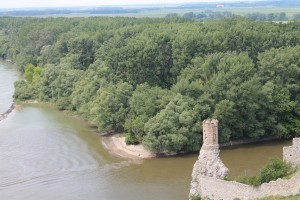
View from Devin Castle ruins
The castle is a worthy day-trip to add to any itinerary that incorporates Bratislava. The old town of Bratislava is postcard-perfect, with spires, russet rooftops and cobbled streets. Brass crowns set into the pavement trace the old coronation route past ice-cream parlours and pavement cafes, and if you choose to step beyond the old town, you will find a vibrant modern city. And just a short trip from the famed old town is the rural beauty of Devin.
Getting There
Devin Castle is a ten minute drive from the centre of Bratislava, or it can be reached by taking bus 28 or 29, departing from underneath the city’s iconic Novy Most every half hour. If you fancy a slower and more scenic route, however, sightseeing boats run from Bratislava city centre to Devin twice daily from April to September.
My friend and I spent the ninety-minute trip upriver in the open seating area to enjoy the specatular views of Bratislava Castle and the Novy Most, and although we nearly froze in the stiff winds, some hot drinks and croissants from the refreshment stand below deck sustained us. In spite of my numb fingers, if there is a better travel experience than sitting on a boat in a strong wind, with a pot of good tea and a friend, I haven’t found it.
In high season (early May to early September) there is a two-hour stopover at the castle, which we didn’t find nearly enough – largely because we had tea in the village of Devin as soon as we disembarked. In the low season (April and September) the stopover is just one hour, which could be quite tight unless you plan your visit well and save lunch until your return to the city. A return ticket costs €8 and a single ticket €6, so it may be worth the extra €2 to keep your options open.
Devin
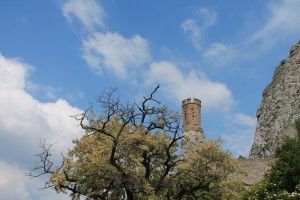
The Maiden’s Tower at Devin Castle, birthplace of legends!
From the boat, the winding path leading to the Castle passes a large heart-shaped sculpture of wound rusted metal, and a moving memorial to the people who died trying to leave Communist-controlled countries. Combined with the pleasant views of the riverside, it is worth taking your time to enjoy the stroll and visit the memorial.
The castle ruins themselves are striking, with numerous passageways, small flights of stairs to climb and patches of grass and wildflowers to wander through. Informative signs are written in both Slovakian and English. Inhabited since at least the ninth century AD, and possibly earlier, the castle has been a residence, a look-out post and a military border fortress at various times in its long history. It was destroyed by Napolean’s forces in 1809 and was owned by the counts of Plaffy until it was purchased by the state in 1935 for a symbolic sum.
The watchtower, a tiny structure perched on an outcrop of rock, is now known as the Maden’s Tower and has also been dubbed ‘The Nun’. It has given rise to countless legends, usually involving an imprisoned woman and a desperate leap into the river below, and it is undoubtedly a striking and romantic sight. But it is the view, taking in the Danube, the Moravia, the countryside of Austria and Slovakia, and the grey smudges of cities in the distance, that is the true highlight.
The day we visited, below the castle was a small collection of market stalls selling souvenirs and handmade jewellery. There was also a choice of places to eat, and we had a nice lunch of chicken and venison at an outdoor table in the shadow of the ruins. The bus brought us back to the city centre within twenty minutes, leaving us with the rest of the afternoon free. Without the boat trip, we could have ‘done’ Devin in a morning, but reaching the castle by water is an experience that I would recommend to anyone with a fondness for travelling by boat – and anyone with a high tolerance for windy weather.
The post Slovakia: Devin Castle on Bratislava’s Doorstep appeared first on We Said Go Travel.
We Said Go Travel
We Said Go Travel is a global community of over sixteen hundred writers with articles from every continent.
Stories are shared with photos and video from a perspective of the transformative power of travel. We Said Go Travel has hosted live and online events as well as travel writing contests around the world. ...more
- Lisa Niver's profile
- 57 followers


